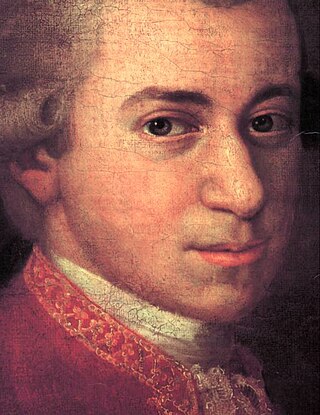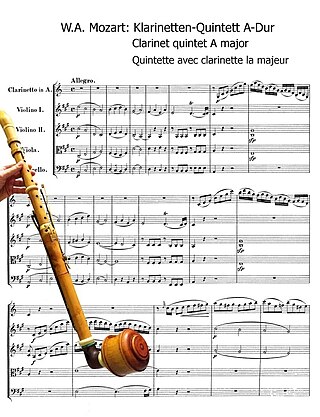Related Research Articles
Anton Paul Stadler was an Austrian clarinet and basset horn player for whom Wolfgang Amadeus Mozart wrote, amongst others, both his Clarinet Quintet and Clarinet Concerto. Stadler's name is inextricably linked to Mozart's compositions for these two instruments.

The Piano Concerto No. 17 in G major, KV. 453, by Wolfgang Amadeus Mozart, was written in 1784.

The basset horn is a member of the clarinet family of musical instruments.

The Requiem in D minor, K. 626, is a requiem mass by Wolfgang Amadeus Mozart (1756–1791). Mozart composed part of the Requiem in Vienna in late 1791, but it was unfinished at his death on 5 December the same year. A completed version dated 1792 by Franz Xaver Süssmayr was delivered to Count Franz von Walsegg, who had commissioned the piece for a requiem service on 14 February 1792 to commemorate the first anniversary of the death of his wife Anna at the age of 20 on 14 February 1791.

Wolfgang Amadeus Mozart's Clarinet Concerto in A major, K. 622, was completed in October 1791 for the clarinettist Anton Stadler. It consists of three movements, in a fast–slow–fast succession.

The Piano Concerto No. 21 in C major, K. 467, was completed on 9 March 1785 by Wolfgang Amadeus Mozart, four weeks after the completion of the previous D minor concerto, K. 466.

Wolfgang Amadeus Mozart's Clarinet Quintet, K. 581, was written in 1789 for the clarinetist Anton Stadler. A clarinet quintet is a work for one clarinet and a string quartet. Although originally written for basset clarinet, in contemporary performances it is usually played on a clarinet in A. It was Mozart's only completed clarinet quintet, and is one of the earliest and best-known works written especially for the instrument. It remains to this day one of the most admired of the composer's works. The quintet is sometimes referred to as the Stadler Quintet; Mozart so described it in a letter of April 1790. Mozart also wrote a trio for clarinet, viola and piano for Stadler, the so-called Kegelstatt Trio, in 1786.

The Kegelstatt Trio, K. 498, is a piano trio for clarinet, viola and piano in E-flat major by Wolfgang Amadeus Mozart.
The Andante in C for Flute and Orchestra, K. 315/285e was written by Wolfgang Amadeus Mozart in 1778 and commissioned by Ferdinand De Jean as a possible replacement or alternative second movement for the Flute Concerto No. 1 in G major.

Wolfgang Amadeus Mozart's Horn Concerto No. 3 in E-flat major, K. 447, was completed between 1784 and 1787, during the Vienna Period.

Piano Concerto No. 5 in D major, K. 175, was composed by Wolfgang Amadeus Mozart in 1773, at the age of 17. It is Mozart's first original piano concerto; his previous efforts were based on works by other composers. In 1782, he revised the score and composed a new rondo, adding a flute to the instrumentation.

Wolfgang Amadeus Mozart's Piano Sonata No. 9 in D major, K. 311 / 284c, was written on the composer's stay in Augsburg and Mannheim in November-December 1777, and is contemporaneous with his Sonata No. 7 in C Major K. 309. The three sonatas K. 309–311 were published as a set 'Opus IV' in about 1782, by Franz Joseph Heina in Paris.

For the last seven years of his life Wolfgang Amadeus Mozart was a Mason. The Masonic order played an important role in his life and work.

The Missa brevis in G major, K. 140, K3 Anh. 235d, K6 Anh. C 1.12, was probably composed by Wolfgang Amadeus Mozart shortly after returning to Salzburg, in March 1773, from his third trip to Italy.

The Sparrow Mass is a mass in C major K. 220/196b, Mass No. 9, Missa brevis No. 5, composed by Wolfgang Amadeus Mozart in 1775 or 1776 in Salzburg. The mass is sometimes termed a missa brevis et solemnis, because it is short in a simple structure as a missa brevis, but festively scored like a missa solemnis with brass and timpani in addition to four soloists, strings and organ. It was possibly first performed on 7 April 1776 in a mass for Easter at the Salzburg Cathedral. The nickname is derived from violin figures in the Hosanna which resemble bird chirping.
The Symphony in D major "No. 51", K. 196+121, was composed by Wolfgang Amadeus Mozart in 1774–1775. The first two movements are from the overture to the opera La finta giardiniera, K. 196, and the last movement, K. 121/207a, was composed separately in 1775.

The Symphony in A minor "Odense", K. Anh. 220/16a, was formerly attributed to Wolfgang Amadeus Mozart. If the Odense Symphony had truly been Mozart's, it would be among only three of Mozart's symphonies to be written in a minor key. It is now considered certain that the symphony is not by Mozart.
The Kyrie in D minor, K. 341/368a, is a sacred composition for choir and large classical orchestra by Wolfgang Amadeus Mozart. It is a setting of the Kyrie, the first section of the Mass, using an orchestra of two flutes, two oboes, two clarinets in A, two bassoons, two trumpets in D, four horns, two timpani in D and A, organ, and strings, as well as the chorus. It lasts approximately seven minutes in performance.
This article lists some of the modern completions of the Requiem by Wolfgang Amadeus Mozart.
References
- 1 2 Heartz, Daniel (2009). Mozart, Haydn and Early Beethoven: 1781–1802. New York: W. W. Norton. p. 443.
- ↑ "Symphonies: Series IV — Orchestral Works" (PDF). Neue Mozart-Ausgabe . 10 (11): IX. Retrieved November 6, 2018.
- ↑ Rosselli, John (1998). The Life of Mozart. Cambridge University Press. p. 116.
- ↑ Cliff Eisen (2006). The Cambridge Mozart Encyclopedia, Cambridge University Press, Inc. p. 168
- ↑ Score
- ↑ "Mozart: Masonic Funeral Music (Maurerische Trauermusik) KV 477 - arrangement matching the orchestration of the Requiem KV 626".
- ↑ "Mozart Requiem", Schlosskirchenmusik Bayreuth, November 2021 (in German)